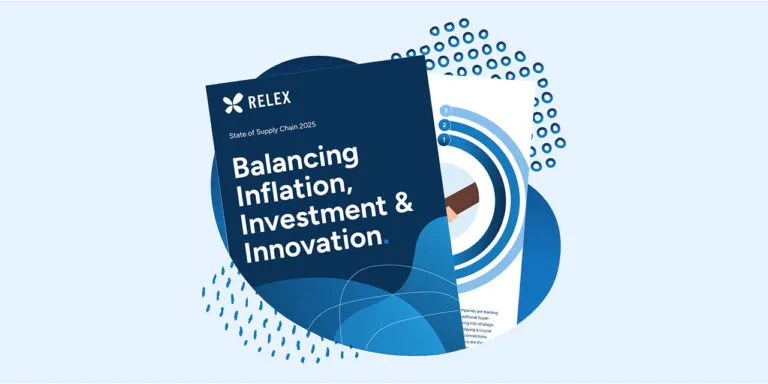Strategies to meet Coronavirus demand increases despite inventory scarcity
Mar 20, 2020 • 4 min
My colleague Janne has already written about how retailers should manage the extreme demand increases resulting from coronavirus-related consumer stockpiling. He recommended that retailers lean heavily on the expertise of their demand planners to continuously monitor sales and guide their planning systems toward corrected forecasts.
Beyond that, though, retailers must maintain transparent, proactive relationships with their suppliers and across internal teams if they hope to maintain availability despite limited inventory during this unprecedented period of high demand.
Share Corrected Forecasts with Suppliers
Janne described how retailers can use technology to automate their demand planners’ business decisions — changing forecasting models or safety stock levels, for example — instead of trying to automate actual forecast calculations. Generating corrected forecasts isn’t the end goal, though. The end goal is ensuring high availability as customers continue stockpiling at record levels to prepare for expected quarantines.
To achieve that, you must ensure that your vendors — both primary and alternate — have full visibility into your projected demand. Say you typically order 1,000 units of a product per week but are correcting to 3,000 units for next week. Your supplier needs to know of that change as soon as possible — ideally, in close to real time — so they can reserve that stock for you. Accurate forecasts are useless if they’re not shared in time to secure inventory.
Ensure Internal Visibility Across Departments
A change in demand has rippling repercussions across retail operations. That’s why it’s equally important that you share corrected forecasts across all relevant functional areas within your organization.
Your distribution centers need to review forecast corrections in a timely manner to ensure they’re appropriately staffed and have enough space for incoming inventory. Sharing store-level projections ensures your planning system can allocate the right amount of product to stores based on greatest need, which may vary greatly from location to location at the moment.
Workforce planners need to know how much product is being delivered and when to ensure they have enough staff on hand to unload shipments and get products on shelves as quickly as possible. At the moment, it’s more important to have employees focused on picking and packing items for home delivery than working on the store floor to assist customers, so workforce planners need visibility into demand by channel as well.
Sharing detailed forecast information both externally and internally is the best strategy to mitigate against the disruptive impact of demand increases across retail operations.
Keep an Eye on Vendor Pricing and Constraints
Price increases become likely any time demand outpaces available supply, so buyers must closely track vendor pricing. Maintain clear lines of communication with your suppliers about their available supply, and make use of your planning system’s vendor pricing capabilities to anticipate when price levels no longer make sense for your business. By proactively monitoring prices, your buyers can determine whether it makes sense to place orders for just the next week’s demand or whether they need to buy a large amount of advance inventory at an optimal price.
You should also keep vendor constraints in mind as you’re reevaluating order sizes. In the past, it might have been smarter to place a small order at a higher delivery fee if demand couldn’t keep pace with a vendor’s larger batch size. With this increased demand, though, it may well make sense to switch to larger orders until demand returns to normal levels.
Allocate Limited Inventory Wisely
We’re seeing inventory scarcity for both short and long lead time items at our customers, especially in the wake of the Chinese manufacturing slowdown related to the COVID-19 outbreak. For both product types, retailers must be strategic about how they match allocation to demand when they have limited inventory.
For example, you may soon receive a shipment of beach towels that were shipped from China before the current public health crisis began. With self-quarantining and social distancing in place across the globe, though, beach towels are in low demand. It makes sense to allocate them to the stores where demand is more evident — stores near private beaches, for example.
More importantly, though, retailers must focus on the high-demand products right now, adjusting allocations and space plans to ensure critical items are available in the necessary amounts to all shoppers. No matter how many beach towels you have on hand right now, your customers on the sunniest coast in Florida still need canned goods and hygienic products more.
Many of our customers are also addressing limited inventory by planning a reduction in presentation stock. Though attractive displays enhance the shopping experience and promote sales, it’s far more important right now to make as much product available for sale as possible.
The Importance of Supplier Diversity
Ideally, retailers already had alternate vendors for their critical categories before sales began rising. If not, you should certainly be actively searching for them now — both domestically and from markets that have lower risk. For many, though, it’s already too late to secure alternate vendors. The Guardian reported that only 7% of retailers surveyed in the UK believe they have “enough flexibility in their supply chain to be able to switch suppliers.”
Supply chain crises like this highlight the dangers of single-sourcing from one market. The best practice, even under normal conditions, is to always maintain a diversified supplier base to guard against disruptions in one market.
Even if you’re not in a position to secure alternate vendors, though, the methods I’ve discussed here should help you achieve the best possible outcomes until this crisis passes. In times like these, it’s our responsibility in retail to make sure the communities we serve have the supplies they need to support their families. Work proactively with your vendors and your internal teams to maintain availability for your customers as they prepare for the weeks to come.



